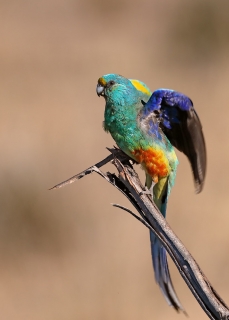Mulga Parrot |
|
|
Also known as: Many-colored Parrot or Parakeet, Varied Parrot
Photos
View in GalleryDid You Know?
The name "mulga" comes from the vegetation type that this species favours in Australia. The Mulga Parrot is also known as the "Many-coloured" Parrot.Academic Research
Related publications: Psephotellus variusSpecies Profile
Genus: Psephotellus | Species: varius
Size:
28cm (11 in)
Weight:
50-70g (1.75-2.5 oz)
Subspecies including nominate:
one
Colour Adult:
Male-in general bright green; frontal band yellow; hindcrown patch brown/red; yellow abdomen and thighs, with varying red marks; green rump and tail coverts, with brown/red near base of tail, and yellow/green band across rump; dark blue/green line across lower back; wing patch bright yellow. Bill dark grey. Eye brown. Female-brown/olive head, back and upper breast; pale green lower breast to undertail coverts; orange/yellow faint frontal band, often tinted with brown/red; dull red/brown patch on hindcrown; wing patch red.
Colour Juvenile:
Juvenile females duller than adult female; pale green outer lesser wing coverts margined with red; juvenile males much duller than adult male, with red on abdomen and thighs minimal or absent.
Call:
Contact call soft and twittering, repeated rapidly three or four times; also soft, musical chattering while perched.
Listen NowVideo Links:
Video 1More Information:
Content Sources:
CITES
BirdLife International
Cornell Lab of Ornithology/Birds of the World
A Guide to Parrots of the World, Juniper and Parr, 1998
Parrots of the World, Forshaw and Cooper, 1977. 2010 edition
Parrots of the World, Forshaw, 2006.
Parrots in Aviculture, Low, 1992.
Photos
View in GalleryDid You Know?
The name "mulga" comes from the vegetation type that this species favours in Australia. The Mulga Parrot is also known as the "Many-coloured" Parrot.Academic Research
Related publications: Psephotellus variusSpecies Care
Captive Status:
Fairly common; more so in Europe than in UK or US.
Longevity:
12+ yrs
Housing:
Walk-in enclosure, minimum length 3m (9.8 ft).
Diet:
Small seed mix such as: canary, millet, and smaller amounts of oats, buckwheat, safflower and a little hemp; limited sunflower seed; spray millet; green leaves daily such as: Swiss chard, lettuce, sowthistle, dandelion, chickweed; seeding grasses, rearing food made from: hardboiled egg, wholegrain bread and carrot, all ground to crumbly consistency; fruits such as: apple, pear, orange, banana, pomegranate, cactus fruits, kiwi; complete kibble.
Enrichment:
Enjoys both dust and water bathing; if dust bathing in outside aviary de-worm regularly. Avid chewers so provide bird-safe, unsprayed flowering, fir, pine and willow branches; provide different sized perches for foot exercise; wooden toys and heat sterilized pine cones. Also swings, ladders and ropes for climbing.
Nest Box Size:
Vertical box 6" x 6" x 16" (15.2cm x 15.2cm x 40.6cm).
Clutch Size:
4-7
Incubation Time:
19 days
Fledging Age:
4-5 weeks
Hatch Weight:
Not recorded.
Peak Weight:
Not recorded.
Weaning Weight:
Not recorded.
Specialist Club:
Photos
View in GalleryDid You Know?
The name "mulga" comes from the vegetation type that this species favours in Australia. The Mulga Parrot is also known as the "Many-coloured" Parrot.Academic Research
Related publications: Psephotellus variusSpecies Wild Status
World Population:
Unknown, decreasing.
IUCN Red List Status:
Least Concern
CITES Listing:
Appendix II
Threat Summary:
Not globally threatened. Locally common but is uncommon in SW Australia due to mallee Eucalyptus gacilis clearance. Although some decline in numbers may have occurred since European settlement there is no evidence of range contraction.
Range:
Interior of S Australia.
Habitat:
Found in dry open woodlands and plains with different vegetation types including mallee, mulga, casuarina, saltbush and sea samphire. Also may be seen in mallee scrub and nearby croplands and in dry parts of riverine woodland.
Wild Diet:
Takes grass, herb, shrub and tree seeds including mulga and Acacia tetragonophylla, mistletoe Amyema murrayi, the saltbushes Atriplex vesicaria and Enchylaena tomentosa, chickweed Cerastium glomeratum, Chenopodium, Kochia, Bassia, Erodium and Lysiana exocarpi. Also recorded taking small grubs.
Ecology and Behaviour:
Feeds on the ground beneath trees, along roadsides, amongst foliage or on spilt grain on farms. Birds feed and drink morning and evening, resting during the hottest part of the day. Are fairly tame when feeding, flying up to treetops when disturbed.
Clutch and Egg Size:
4-7 rounded eggs, 24.0 x 19.0mm (0.9 x 0.7 in).
Breeding Season:
July-December, but can extend throughout year if conditions are favourable. Nest is in hollow limb or tree cavity.
Related Links:
Photos
View in GalleryDid You Know?
The name "mulga" comes from the vegetation type that this species favours in Australia. The Mulga Parrot is also known as the "Many-coloured" Parrot.Academic Research
Related publications: Psephotellus variusMembers Only Resources
Please log-in now to find more research, resources and tools.
Not a Member?
Find more great information:
Gain exclusive access to 600+ pages of additional research, seminars and podcasts, specialists to ask your toughest questions, and dozens of other fun resources - when you become a WPT member.
Join Today >>

































